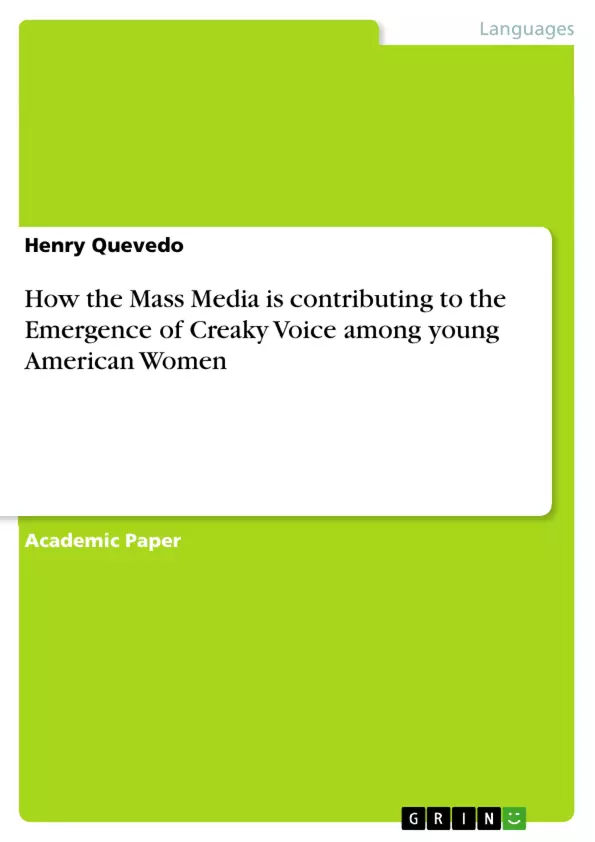In recent years there has been a "hot linguistic fad […] or the verbal tic of doom" that has become increasingly present in the speech of North American women. This linguistic obscurity is creaky voice or vocal fry. It has been commonly referred to as a component of "valley-girl-sound" because of its occurrence was often noticeable in the speech of young women from the west coast of the U.S. – specifically California. Now the trend has spread throughout the United States which has triggered numerous reports on blogs as well as various studies and research concerning this topic. Interestingly, however, most of the recent research conducted on the use of vocal fry among young American women has been about its perception. Yuasa’s study from 2010, for instance, came to the conclusion that creaky voice by American women from northern California and eastern Iowa was perceived as "hesitant, nonaggressive, and informal but also educated, urban-oriented, and upwardly mobile."
While other studies suggest that it could be hurting their job opportunities. While the perception on vocal fry varies, so do the opinions for its emergence among young Americans. Some propose that it is a part of a social identity that young women strive to be a part of. Others suggest that it is a tool to lower the voice in order for it to resemble the male voice which is frequently perceived as more dominant because of its lower pitch. Consequently, this theory means that vocal fry is a tool of empowerment for young women. The theory that will be discussed in this paper, however, will be a different one. I will examine how vocal fry and its popularity among young American women are being spread through the popular women who are prevalent in the media. As Graddol and Swan state:
"It would be surprising if people did not use their voice to project a culturally desirable image. Other parts of the human body which have been endowed with social significance are manipulated, groomed or decorated before being presented in public." This statement gives power to the argument that the not only the vocab but also the phonation in the speech of young women are impressionable by famous and successful women that function as role models for them.
Table of Contents
- Introduction
- What is "Creaky Voice"?
- The Media's Influence on Language
- Media Outlets that frequently feature Creaky Voice by American Women
- Television
- Film
- Social Media
- Music?
- Conclusion
Objectives and Key Themes
This paper examines the prevalence of creaky voice among young American women and explores how the media contributes to its emergence. The study focuses on the influence of successful women in the media, who often use creaky voice, and their role as role models for younger generations. It investigates the influence of different media outlets, including television, film, social media, and music, on the spread of this linguistic feature.
- The emergence of creaky voice among young American women
- The role of media in shaping language and speech patterns
- The influence of successful female role models in the media
- The impact of different media outlets on the spread of linguistic features
- The social and cultural implications of creaky voice
Chapter Summaries
- Introduction: This chapter introduces the topic of creaky voice and its increasing prevalence among young American women. It discusses previous research on the perception of creaky voice and different theories regarding its emergence, focusing on the influence of the media.
- What is "Creaky Voice"?: This chapter provides a detailed explanation of creaky voice, including its physiological processes and its natural occurrence in speech. It examines the acoustic characteristics of creaky voice and its perceived effects on the speaker's voice.
- The Media's Influence on Language: This chapter explores the role of the media in shaping language and speech patterns, particularly focusing on how media outlets can influence the adoption of specific linguistic features. It examines the potential impact of media exposure on the spread of creaky voice.
Keywords
The key focus of this paper is the emergence of creaky voice among young American women and the role of the media in its propagation. It examines the influence of media figures as role models, the impact of various media outlets, and the potential social and cultural implications of creaky voice.
- Citar trabajo
- Henry Quevedo (Autor), 2018, How the Mass Media is contributing to the Emergence of Creaky Voice among young American Women, Múnich, GRIN Verlag, https://www.grin.com/document/425382



